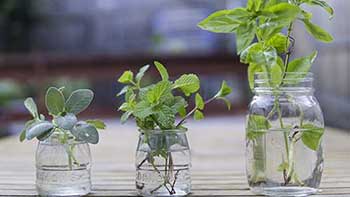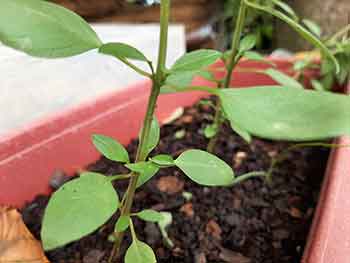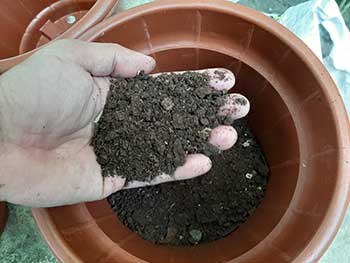One of my favorite herbs to plant in my container garden is basil. I like planting it because it brings in a fresh flavor to the culinary arts. Traditional in a pesto dressing, basil's small leaves have a pungent and delicious flavor. I like to scatter over any tomato salad, particularly one with mozzarella cheese.
Basil is traditionally grown from seeds. But you can also grow basil from cuttings. Here are 8 easy steps in growing basil from cuttings:
- Cut the basil and put it in a wide-rim glass jar
- Choose rain or tap water that has been left overnight
- Prepare the basil cuttings by nipping off the lower leaves
- Put a handful of basil cuttings into the glass jar so that the stems are covered with water
- Don’t forget to change water at least once a week
- Allow the roots to grow a little more once they appear
- When roots start to come out, don’t change the water
- When a good root system has developed, pot the basil cuttings up
Growing Basil From Cuttings
1. Cut the basil and put it in a wide-rim glass jar.

It is best to cut off healthy young shoots with scissors or break off with your hand. Always use transparent jars so you can see if the roots have already grown.
Basil bought from the grocery can also be successfully grown, especially if it is freshly cut.
2. Choose rain or tap water that has been left overnight.
Rainwater is perfect for basil and most house plants, especially if the tap water is hard. Leaving tap water overnight tends to lower its chemical content, especially chlorine.
Chlorine is a chemical used to kill harmful bacteria living in the water. It is what makes water safe to drink. However, the same chlorine may also kill the beneficial microorganisms present in the water or soil.
These microorganisms help break down and decompose organic matter in the soil, turning them into organic fertilizers for your plants. If these microorganisms are killed, then the plants may not get the much-needed nutrients from the soil.
However, studies show that beneficial microorganisms in the soil reproduce quickly. In 3-5 days, the microorganisms will populate the soil again in significant numbers. But for the soil in containers, it may take some time because the soil is basically enclosed in the container.
3. Prepare the basil cuttings by nipping off the lower leaves.
You just need a few at the top of the cutting. Leaves need nutrients to survive and grow. If there are too many leaves, the cutting may not be able to supply every leaf with nutrients since it doesn’t have well-established roots yet. Without nutrients, the leaves will simply die and the cutting will just be overwhelmed.
Trim just below the bottom leaf joint. Leaves submerged in water will just rot. Rotting organic matter in water may introduce harmful bacteria. These bacteria will eat into the stem of the cutting. The smell of rotting organic matter can also attract insects such as mosquitos.
Some people also grow basil cuttings successfully by dipping the cuttings in a rooting hormone. Rooting hormones contain chemical compounds that stimulate root growth from cuttings. When the rooting hormone is applied, the roots start to appear quickly.
If you have some rooting hormone lying around the house, it’s a good idea to use it. It is commonly sold in powder, liquid, or gel form. It increases your chances of rooting. However, I have also achieved success even when a rooting hormone is not applied.
4. Put a handful of cuttings into the glass jar so that the stems are covered with water.
To encourage the roots to grow from the cuttings, place it on a warm, light window ledge or where there is a bright light. You can easily grow the cuttings indoor just by placing them on a windowsill. Light is needed so that the leaves can achieve photosynthesis.
Photosynthesis is a process where plants can produce their own food to grow, including nutrients. For photosynthesis to occur, plants will need water, carbon dioxide, and light. Without bright light, the plant will not be able to grow roots.
5. Don’t forget to change the water at least once a week.
Stagnant water is the perfect place for insects to lay their eggs. To prevent these eggs from hatching, it is best to replace the water in the jar. Old and stagnant water also has an unpleasant smell. By replacing it with freshwater, you are also supplying the cuttings with a fresh batch of micronutrients.
6. After a while, you will see tiny roots starting to appear from the leaf joints along the submerged stems. Allow these to grow a little more.
Plants need a well-establish root system in order to absorb the important micronutrients such as nitrogen, phosphorus, and potassium. This is particularly important if you wish to transplant basil in the soil. The roots will absorb these nutrients from the soil. Without these nutrients, the basil plant cannot produce more leaves.
7. When roots start to come out, don’t change the water. You don’t want to disturb the growth of the roots. Many plants don’t develop fully once their roots are disturbed.
8. When a good root system has developed, pot the basil cuttings up. These will let the basil plant absorb more micronutrients from the soil. You have now successfully rooted your basil cuttings in water!
Transferring Basil Cuttings from Water to Soil
You may let the plant grow on water or plant it in soil. If you decide to let it grow on water, you may have to add liquid additives to supplement the nutrients of the plant. Also, you have to make sure to maintain the level of water inside the jar.
If you decide to transfer it to soil then you can do the following steps:
- Break up any large clumps of soil to improve drainage. You may need to add garden compost if the soil is a heavy clay type. Other soil amendments you can use are coco peat, sawdust, wood shavings, or dried animal manure.

Use good potting soil - Fill in the pots with loam-based potting compost or topsoil. This will give the young plants a chance to root freely.
- Firm lightly and level off with your hands
- Water frequently for the first 2 weeks. Make sure to keep the soil moist for this time period.
- To keep your plants healthy, pick the leaves and soft stems of the edible kinds frequently, this is especially true for basil.
- If you leave herbs to flower, they attract pollinating insects, but this makes the foliage of edible kinds less tasty.
Taking Care of Basil Plants
Basil needs six to eight hours of sun per day. Water the plants freely during dry periods and once flowering begins, pinch off the flower heads to encourage the leaves to continue to grow. Basil does best in soil with a pH of 6 to 7.

Since basil likes moisture, place mulch in the pot or around the plants to help retain moisture. Basil should be pruned once the plant has six to eight leaves. After the basil plant is six weeks old, pinch off the center shoot to keep flowering at bay.
The biggest threat to a basil plant is root rot from poor drainage, so ensure the planting site has adequate drainage. Also, watch out for pests such as aphids, slugs, or Japanese beetles.











